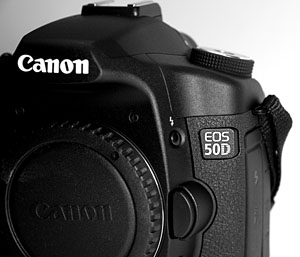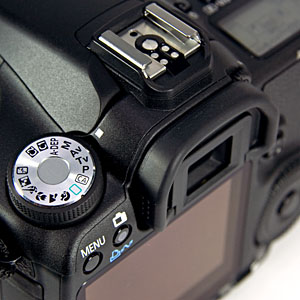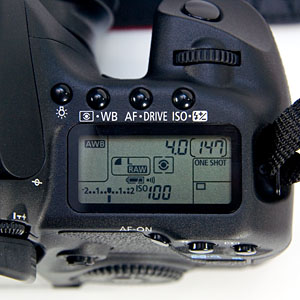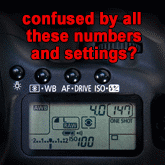Then Canon EOS 50D body was announced by Canon in late August, just 12 months after the 40D. Historically, Canon has typically waited 18 months between successive releases, and as a result, the 50D was a somewhat unexpected announcement.
After having used a Canon 350D (Digital Rebel XT) for two and a half years, I decided it was time to upgrade, and purchased a Canon 50D body just over a week ago.
This post isn't intended to be a full review of the 50D, but I'll share my initial thoughts and impressions after using the 50D for a week.
While I've bought photography gear from the US previously because it was significantly cheaper than local prices, this time, due to the Australian dollar slipping, it was cheaper to purchase it locally.
I bought the 50D from Gerry Gibbs Camera House in Cannington. They had received their first batch of 50D bodies a couple of weeks ago, but they had all been pre-sold. Their second batch arrived on Thursday 25 September, so they had stock that was immediately available, and I picked one up on Friday 26 September.
Here's the key specifications of the 50D body:
| Sensor |
22.3 x 14.9 mm CMOS sensor
15.1 million effective pixels 3:2 aspect ratio |
| Image processor | DIGIC 4 |
| Image sizes |
large: 4752 x 3168 (approx 15.10 megapixels)
medium: 3456 x 2304 (approx 8.00 megapixels) small: 2353 x 1568 (approx 3.70 megapixels) RAW: 4752 x 3168 (approx 15.10 megapixels) sRAW1: 3267 x 2178 (approx 7.10 megapixels) sRAW2: 2376 x 1584 (approx 3.80 megapixels) |
| Lenses |
Canon EF / EF-S lens mount
1.6x field of view crop |
| Autofocus |
9 AF points (all cross-type for lenses of F5.6 or faster)
Center point additionally sensitive with lenses of F2.8 or faster |
| Focus modes |
One shot AF
AI Servo AF AI Focus AF Manual focus |
| AF microadjust |
+/- 20 steps
Adjust all lenses by same amount/individually adjust up to 20 lenses |
| Metering modes |
35-zone TTL full-aperture metering
-Evaluative metering (linkable to any AF point) -Partial metering (approx. 9% of viewfinder at center) -Spot metering (approx. 3.8% of viewfinder at center) -Center-weighted average metering |
| Exposure compensation |
+/-2.0 EV
0.3 or 0.5 EV increments |
| Sensitivity |
Auto ISO in basic modes: 100 - 1600
creative modes: ISO 100 - 3200 (in 1/3 or 1 stop increments) expandable to ISO 6400 or 12800 |
| Shutter |
electronically controlled focal-plane shutter
100,000 exposure durability 1/8000 - 30 seconds (in 1/3 or 1/5 stop increments) Bulb |
| Aperture values |
F1.0 - F91
0.3 or 0.5 EV increments Actual aperture range depends on lens used |
| LCD monitor |
3.0" TFT LCD
920,000 pixels (VGA) 7 brightness levels 160° viewing angle |
| Drive modes |
Single
High-speed continuous: 6.3 fps Low-speed continuous: 3 fps Self-timer (2 sec or 10 sec delay) |
| Burst buffer |
Large/Fine JPEG: 90 frames with UDMA card; 60 frames without
RAW: 16 frames Large/Fine JPG + RAW: 10 frames |
| Storage |
Compact Flash Type I or II (inc. FAT32)
Supports UDMA cards |
| Dimensions | 145.5 x 107.8 x 73.5 mm (5.7 x 4.2 x 2.9 in) |
| Weight |
Body only: 730 g (25.7 oz)
With battery: 822 g (28.8 oz) |
For the complete list of specifications, refer to Canon's website or dpreview.com.
3" LCD Screen
When using the 50D, one of the first things that really struck me is the size, brightness and clarity of the 3" LCD screen on the back of the camera. It is VGA resolution, and works very well for reviewing photos, allowing you to zoom in and see the details of a photo. It's a huge improvement to the small 2" LCD screen that I'm used to using on the 350D.
Menus
On the large LCD, the menus are easy to read, and the navigation is convenient, with the main dial (adjacent to the shutter button) used to move between the tabs (ie, "pages") of the menu, and the quick control dial (the large dial on the rear of the body) used to move up and down between menu items. The various tabs of the menu are colour-coded, to provide a quick visual indication which menu you're looking at.
My Menu
The "My Menu" page allows you to register any six menu items or custom functions on one of the menu tabs, providing quick access to settings that you require easy access to.
Body
The body is well balanced, and fits comfortably in my hand. The grip is large enough for me to hold with my (large) hand, without my smaller fingers falling off the bottom of the grip.
Liveview
The liveview functionality seems more of a gimmick than something that's going to be useful, but I'll need to spend some time using it to see just how useful it'll be. I can see it being useful for macro shots, and other setup shots where the camera is mounted on a tripod.
Someone recently hacked a 40D to record video using the liveview buffer, so maybe it'll be useful in a way that Canon didn't intend for it to be used...
High ISO Support
The 50D supports ISO 100-3200, and is expandable to 6400 and 12800. While I haven't had a chance to experiment with the higher ISO settings, from what I've read, the 50D's high ISO work very well, with minimal noise, and should be ideal for lower-light photography.
While my comments till now have been positive, there's a couple of not-so-positive things worth mentioning.
Battery Compatibility
Upgrading from a 350D to a 50D means I need to buy some new batteries, as the 50D takes a BP-511A, which is a different form-factor than the 350D's NB-2LH. However, I also have a Canon G5 point'n'shoot which takes the BP-511A, so I can share batteries between the G5 and the 50D.
Proprietary N3 Remote Connector
The Canon 50D uses Canon's proprietary N3 connector for accepting connections from remote triggers, and this means I cannot use my homebrew wired remote with the 50D. After some research, it turns out that the N3 connector cannot be purchased separately, but I'll save my solution for another blog post.
More Pixels Means More Storage Required
With the 15.10 megapixels of the 50D, it now means I'll be filling up my compact flash memory cards at a faster rate. Not only that, but I'm keeping the 350D as a backup body, and for my children to use, so I need to share my compact flash cards between the 50D, 350D and G5. As a result, I'll be buying some more larger CF cards in the near future.
A second impact of the larger image file sizes is the rate at which disk space on my computer will be consumed. This also applies to my backup drives, so I may need to revisit my backup strategies, although I shouldn't run into any issues in the short term.
I've only had the 50D in my hands for a week, and haven't yet had the opportunity to fully exercise its functionality. However, I'm enjoying it so far, and am finding it easy to use. I'll post more detailed information about different aspects of the 50D when I get a chance to write some additional posts.
- Canon 50D press release (Canon USA website)
- Canon 50D homepage (Canon Japan website)
- Canon 50D Specs (dpreview.com)
- Canon 50D Preview (dpreview.com)






Can't wait to read your remote solution....as far as the backup drives and space and that, what do you have in mind? The one thing that I don't like about digital media is having to figure out how to store and back up all the data in a way that is efficient and effective!